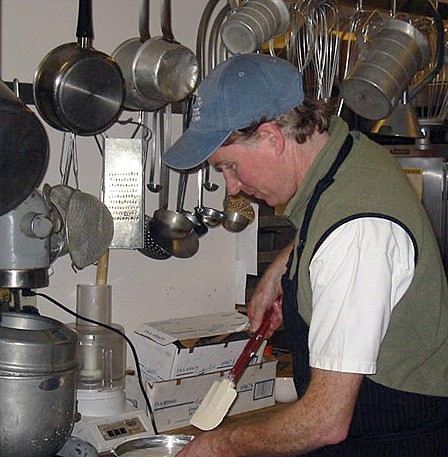Geddes Martin, chef at the Inn at Ship Bay restaurant, knows how to make more than 300 kids, parents and teachers smile: serve them herb roasted chicken, mashed potatoes with mushroom gravy, carrots, and plum crisp with fresh whipped cream on “Celebrity Chef” day at the public school cafeteria.
This once-a-month Farm to Cafeteria event during the school year has become a real favorite, say organizers.
“It has bolstered the number of students eating in the school cafeteria as well as the community’s involvement and excitement about the Farm to Cafeteria Program as a whole,” Farm to Cafeteria Committee Chair Madie Murray said.
Although patterned after Lopez Island’s harvest meals, where island chefs prepare dinner for the entire community at their school cafeteria once a month, Orcas school’s celebrity lunch day is not a fundraiser. It has, however, increased the school’s food service revenues. Normally, a school cafeteria is a drain on the school’s budget, which is why many schools are considering dropping food service altogether. By using more local, organic foods, practicing scratch cooking methods and raising the overall quality and nutritional value of school lunches, it is possible for the cafeteria to actually become self-sustaining as more students, teachers and parents buy lunch in the cafeteria.
So far this school year, the number of students, teachers and parents having lunch in the school cafeteria has increased by almost 23 percent – from an average of about 190 to 230 per school day.
“Ideally, we would like to serve an average of 300 plus a day, but that is no small task, especially for our small cafeteria kitchen staff, kitchen, equipment and prep areas,” Murray said. “But, at that number and with a slight increase in the cost of lunch, profitability becomes possible.”
This school year, the Farm to Cafeteria Program has been able to further its purpose to provide public school kids with not only nutritious and delicious food in the cafeteria, but enrich their knowledge of where food comes from, how to plant and harvest, and even how to cook. Mandy Randolph’s Farm to Classroom for grades K-4 has planted experiential seeds that have grown and blossomed into an enthusiasm about food.
“What is apparent and important is that school lunches have definitely improved, and our public school is dedicated 100 percent to embracing local food sources and meals we are proud to serve,” Murray said.



